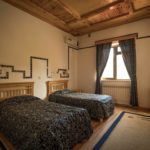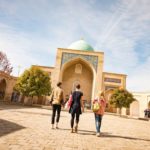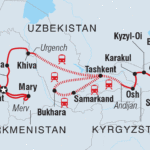Bishkek to Ashgabat
Be entranced by the beauty and the wonder of Central Asia on this overland journey from the capital of Kyrgyzstan through the heartland of Uzbekistan to the forgotten yet futuristic Ashgabat. Take in the tranquil landscape of Son-Kol Lake, watch for wild boar and deer around Chychkan Gorge, hike up the sacred Sulumain-too Mountain in historic Osh, and get your fill of mosques and museums in Samarkand. Venture into the mysterious Turkmenistan, watch the eternal fire from the 'Gates of Hell', and explore Ashgabat with architecture from a sci-fi movie. Abounding with ancient culture, divine natural beauty, intriguing relics and welcoming people, this is a journey that will leave you eager to discover more of Central Asia.
27 days, from
$6,865
per person
GROUP SIZE
ACTIVITY LEVEL
Details
Countries Visited:
Kyrgyzstan
Turkmenistan
Uzbekistan
Accommodation: Guesthouse/Homestay (3 night), Hotel (18 nights), Yurt (4 nights), Overnight train (1 night)
Transportation: Private Bus , Metro , Train , Overnight Train
Included Meals:
- 25 breakfasts
- 6 lunches
- 9 dinners
Group size: Minimum 1, Max 12
Minimum Age: 15
Central Asia is a fascinating and unique mix of ancient Silk Road culture, post-soviet culture and striving to redefine nations post independence. Geographically and for a time historically, it is the real centre of Asia
The much-photographed Registan in Samarkand is one of the true pinnacles of Islamic architecture. You'll be wowed by the scale, grandeur and beauty of the monuments to iconic figures such as Tamerlane and the Persian influenced madressas, mosques and mausoleums
Experience for yourself the legend that is Central Asian hospitality - there's really nothing like being welcomed into a local home or yurt for a meal, chatting with stall holders at bazaars or simply marvelling at the sights alongside locals
Kyrgyzstans mountains are its monuments and its majesty. The landscapes here will stay with you long after the journey is over
Marvel at the beautiful Son-Kol Lake, where in mid-summer you may see flocks of sheep, goats and herds of horses watched over by nomadic herdsmen and their families
Stay overnight in a yurt lakeside and live like the locals have for centuries in these portable, felt lined traditional tents
Reflect on the important role horses have played in the traditional Kyrgyz nomadic life style while witnessing horseback sports like odarysh (wrestling on horseback), tiyin-enish (where riders try to pick up coins at full gallop) or kok-baru (goat polo)
Explore sprawling ruins of Mary, Merv and others with a local guide and contemplate these remnants of empires that once ruled this vast land
Witness the eternal flames of the Darvaza Crater, aka the 'Door to Hell' as you camp nearby – one of the strangest, most mesmerising geological oddities on earth
Ashgabat rose from the devastation of an earthquake in 1948 and has enjoyed a surreal and futuristic makeover
Itinerary
Welcome to Bishkek! Your adventure begins with a welcome meeting at 6 pm tonight. Tomorrow you’ll take a tour of the city, so don’t stress too much if you don’t have time to see much today. Bishkek is tree-lined town of parks and gardens, handsome houses and wide streets perfect for strolling. If you arrive with time to spare, maybe head out in search of some samsa (pastry pockets filled with meat and vegetables).
Embark on city tour that showcases the various stages of Bishkek’s history. Visit the severe Ala-Too Square, once known as Lenin Square, and learn about the towering statue depicting folkloric hero Manas. Continue to Dubovy Park, and wander among the open-air cafes before strolling between the century-old oaks along Freedom Avenue. In the afternoon, you'll have some free time to further explore Bishkek. Quite the contrast to the relaxed quiet streets, square and parks in the city centre, Osh Market is noisy, crowded, and a perfect peek into local life. You'll find all kinds of things on sale here, from spices and fruits to clothes and carpets.
This morning, up and on the road through the beautiful landscaps of Kyrgyzstan. You'll be travelling with our vehicle for the next few days so get ready for a road trip through some pretty stunning mountains and lakes. Firstly stop at Burana Tower, a minaret that is the most visible
remnant of the ancient city Balasagun. Then continue to Tokmak and meet a local Dungan family and enjoy a home-cooked lunch. Then onto the destination of today - Issyk-Kul Lake, the second-largest alpine lake in the world. At 170 - kilometres-long and 70-kilometres-wide, her beauty is a real sight to behold. Your yurt camp for tonight is set up along the south shore of the lake where you'll get a fantastic view of the snow-capped mountains setting behind the lake. Made of felt and tarpaulins on a round frame, yurts are the traditional dwellings of the Kyrgyz people and this will be your 'settlement' for today and tomorrow.
With relaxed plans for today, we’ll wander the beautiful alpine area and head out to meet a local eagle trainer (or Berkutchi) and discover the ancient principles of training these beautiful creatures to follow commands, catch prey and return back to their masters and then visit a few local families who’ll teach you more about their traditional yurts. With a special workshop, you’ll learn the basics of how these nomadic dwellings have been manufactured and how they play an important role in the community here. Enjoy a free afternoon and evening, relax in your authentic yurt camp, jump into the lake, ride a bike or sit back with a cold homemade vodka – created by your yurt camp owners, just for you.
Back on the road and travel to Song-Kol Lake, another alpine stunner that is considered a sacred place to many Kyrgyz people, as well as one of the best summer pastures for nomadic herders. The landscape will change depending on the season but is sure to be beautiful no matter when you travel. In the summer you might see nomadic herdsmen and their families watching over goats, sheep, and horses. Enjoy exploring your surroundings for the rest of the day, maybe hiking one of the many trails. Tonight, fall asleep in yurts set up along the shore. Tomorrow, those daring enough for an invigorating morning splash can use the lake to wash off the sleep.
Travel along gravel roads to the tiny village of Kyzyl-Oi, which is squeezed between mountains. On the way, pass large coal deposits and travel along the Kokomeren River, which feeds into the Syr Darya. Enjoy a picnic lunch on the banks of the river in the shade of the trees and use your free time to explore the village on arrival.
Get ready for a full-day of driving though big, beautiful landscapes. As the roads in Kyrgyzstan see little regular maintenance, even short distances on a map can take hours. The road crosses the Suusamyr Valley – a high steppe plateau situated at around 2200 metres above sea level. The mountainous surroundings are often dotted with yurts. Continue along the Chychkan River that cuts through the Tien Shan mountain range. Stop here for a while and soak up the amazing scenery. Arrive at tonight's accommodation in Kok-Bel sometime in the early evening.
After breakfast, get ready for another all-day journey to Osh, the second-largest city in Kyrgystan. Stop en route at Uzgen, an ancient trading town and handicrafts centre along the Silk Road. Although much of the ancient city has been destroyed, a minaret and three mosques that have survived remain important examples of medieval Central Asian architecture. Continue to Osh. Located in the Fergana Valley in the south of the country, Osh is often referred to as the 'Capital of the South' and is the oldest city in the country.
Rise and shine for a visit to the only World Heritage site in Kyrgystan, the Sulaiman-Too Sacred Mountain, also known as Solomon's Throne. For centuries Silk Road travellers have sought out the mountain's caves and their petroglyphs in the belief that they would be blessed with longevity or healthy children. Visit the National Historical and Archaeological Museum Complex. In the afternoon, enjoy some free time in Osh. Perhaps visit the Jayma Bazaar, where you might pick up an interesting souvenir or two. Or maybe take a self-guided tour of the remnants of Osh's soviet past with a walk to the giant Lenin statue in the city square.
This morning, drive to Kyrgyz-Uzbek border, which is just outside of the city. After passing through the border control, farewell and thank your Kyrgyz guide and meet your new Uzbek guide. Transfer to Andijan and board a local train to Tashkent (approximately 5.5 hours). The train is a great place to meet locals, so don’t be surprised if people want to chat to the chet ellik (foreigner). Arrive in the evening and check into the hotel.
Begin your introduction to Uzbekistan by exploring the capital on a sightseeing tour. Visit the State History Museum, which shows exhibits and collections spanning the countries 5000-year history. Continue to the Abdul Khasim Medrassah, where craftspeople operate in many small ‘cells’, making jewellery and other things. Finally, stop by the Khast Imom complex, a restored series of religious buildings (including a mosque) and a library containing an ancient Qur’an, parts of which have been dated to the ninth century. After lunch, lose yourself in the exciting Chorsu Bazaar, browsing traditional wooden cradles, handmade musical instruments, and the extensive vegetable and spice markets.
Transfer to the station for the high-speed train to fabled Samarkand (approximately 2 hours). This city is located at the very centre of the ancient Silk Road. Arrival around midday and follow your leader on a short city orientation walk. Then enjoy some free time in the city, saving some of the key sights for the tour tomorrow. Maybe inspect the remains of the remarkable medieval observatory developed by Ulug Beg, an astronomer and grandson of nomadic conqueror and Timurid emperor Tamerlane (Amir Timur). Today, only half of the below-ground semicircle track can be seen, but there is a small museum close by that gives some context. Or perhaps visit the Afrosiab Museum of Samarkand, the main attraction of which is a tenth-century mural. After the day at your leisure, you’ll visit a local family to learn the secrets of plov cuisine during a cooking demonstration in the evening.
Enjoy a tour of Samarkand. First up is the central square called the Registan, which features mosques and mausoleums that are true pinnacles of Islamic architecture. Continue to Guri-Amir, where Tamerlane is buried, and then the enormous Bibi-Khanum Mosque. Visit Shak-i-Zinda, a necropolis that features a series of gleaming blue-tiled mausoleums. This sacred site has monuments from the 14th–19th century, reflecting the development of the monumental art and architecture of the Timurid dynasty onwards. It is photo worthy at every turn, just remember to be respectful as pilgrims visit the complex.
Travel from Samarkand to Bukhara by train this morning. Located on the ancient Silk Road, Bukhara was an important regional and world hub for many, many years and has a long, fascinating history featuring invasions by both Genghis Khan and the Soviet Red Army. Explore this fascinating city with your tour leader on an orientation walk after arrival and head to the Lyabi-Haus area, a busy 17th-century plaza with hundreds-years-old trees and there is time to wander the small craft studios tucked into the nearby madrasas and trading domes.
Enjoy a day of sightseeing in beautiful Bukhara. First visit the Sitorai Mohi Khosa, once the summer residence of the last Emir. Designed by Russian architects, it has interiors decorated with traditional filigree plaster, mirrored surfaces and delicate floral wall paintings by local artisans. Continue to the 16th-century Chor-Bakr necropolis, where not many tourists venture. Walk through the madrasa and mosque complex. In the afternoon, visit the Ark Fortress and Kalon Mosque, the symbol of Bukhara. Continue to one of Central Asia's oldest and most exquisite structures, the tenth-century Ismail Samani Mausoleum, the superb decorative brickwork of which has survived 1000 years of rugged history.
Enjoy some free time for your own optional sightseeing in Bukhara. In the afternoon, take a fast train back to Tashkent followed by an optional dinner with your fellow travellers.
Today is a free day for you to explore Tashkent until 6pm group meeting to meet your new travel buddies.
Take morning flight to Urgench (90 minutes) and transfer to colourful Khiva (45 minutes). Many global powers have laid claim to this city over the centuries, from khans to Silk Road traders and the Soviet Union. Get acquainted with Khiva on a tour of this walled-city. See the incredible blue-tiled Kalta Minor Minaret and the Mohammed Amin Khan Madressa. Explore the Kuhna Ark, the 'citadel within a citadel' which once housed the Khan and his family in the 17th century, then get a good look at this attractive city from the Ak-sheikh Baba Observatory. Finally, visit the Pahlavon Mahmud Mausoleum, a complex constructed in honour of the famous 13th-century poet, craftsman and fighter. A popular pilgrimage site, the mint-coloured dome that tops the main mausoleum is stunning. Spend the rest of the day as you wish. Maybe ask your leader where to grab the best plov (rice, meat, and carrots). The city is a photographer's delight, particularly in the evenings when the sun begins to set and fading light glints off turquoise tiles, so make sure you have your phone or camera ready to snap some pictures.
Khiva is particularly magic at dawn when the streets are empty. Later, you leader will guide you through some of the city’s other impressive monuments and buildings. Visit the towering Islom Hoja Minaret, the tallest building in Khiva. Explore Juma Mosque, the roof of which is propped up by 212 wooden columns and designed to let in sunlight. If you want a peek at Uzbek luxury, look no further than the Tosh-Hovli Palace, which was built in the first half of the 19th century. Wander through elaborately decorated courtyards connected by labyrinthian corridors. The rest of the afternoon is yours to relax.
Say goodbye to Uzbekistan and cross the border into Turkmenistan at Khodjeyli (Xo‘jayli). Meet the new leader who will be your key to local secrets, food and highlights for the rest of your journey. From the border, make a 1.5-hour drive to the World Heritage-listed Konye-Urgench. Once a centre of the Islamic world, it suffered destruction at the hands of Genghis Khan and the Timurid dynasty and fell into decay until the 20th century. But it still has tonnes of monuments from the 11th to 16th centuries, including a mosque, mausoleum and the 60-metre-high Gutlug Timur Minaret. Continue your journey with a 4-hour drive by 4WD to Darvaza Crater. This astounding 70-metre-wide hole in the Karakum Desert is permanently aflame. Soviet oil prospectors started drilling in 1971 expecting to find oil, and the ground collapsed to form the crater. Worried about the gas released into the air, they deliberately set the crater on fire to burn off the excess, expecting it to last a few weeks. As you’ll see today, they were wrong, and the crater has been burning ever since. Watch the sunset over the 'Door to Hell' from your nearby camp, and enjoy a Turkmenistan-style barbecue for dinner.
Hit the sand again in the 4WD, making the 4-hour drive to Ashgabat with a stop along the way at the tiny settlement of Yerbent. The community here live primarily in yurts that are tucked between the sand dunes. Check out the local monument that pays tribute to the group of socialists that died in the Basmachi Revolt in 1931, then continue to Ashgabat. Little is left of the original Russian Imperial city as most of it was destroyed in a massive earthquake in 1948, and today the city centre is a bizarre mix of futuristic and outrageous public buildings. Get a sense of Ashgabat old and new with a tour that takes in both the ancient settlement of Nisa and the National Museum of Turkmenistan. Enjoy a free afternoon in this mind-bending city. Look out for the ornate, golden telephone booths, screens broadcasting official ceremonies on a loop and imposing statues of the president.
Take a full day to wrap your head around this desert city on an immersive guided tour taking in the four pointed minarets atop the Ertugrul Gazi Mosque and the the extravagant Independence Monument. This sculpted park is filled with statues of Turkmen heroes (and controversial politicians) that line paths that lead to a golden dome and a (surprise!) massive minaret. From this lavish ode to Turkmen identity, continue to the Neutrality Arch, which despite its name has a provocative history. Then travel outside of the city to the Turkmenbashy Ruhi Mosque, the mausoleum of former Turkmen leader Saparmurat Niyazov, before heading further out of town to the ruins of Anau. The crumbling remains of the medieval mosque still attract the devout, who come to pray and make offerings. After a day full of sightseeing, maybe spend the evening relaxing at your hotel.
Rise and shine for the 5-hour drive to Mary (pronounced ‘Mah-rih’). The somewhat ostentatious displays of wealth in the city can be traced to the long-running gas and cotton industries. Stop en route for lunch and to roam through the ruins of Abiverd. This fascinating archaeological site was an important trading town from 652 AD until the 12th century, and you can still see ancient shards of pottery scattered on the ground. Arrive in Mary in the afternoon and settle into your hotel.
Take a 40-minute drive to Merv, also known as Margiana or Margush, and enjoy some time to explore Turkmenistan's most recognised site. This sprawling World Heritage site is home to numerous walled structures from various periods spread across a 1200-hectare area. See impressive columns smoothed by wind and time at the Greater Kizkala and walk hills that were once the fortress walls of Erk Kala. While not the most impressive visually, Gyaur Kala dates to 400 BC and has a fascinating history. Spend some time exploring these relics of grand empires and then return to Mary for a free afternoon. Maybe visit the Mary Regional Museum. Housed in a palace of white marble, the museum features archaeological displays and exhibitions on traditional Turkmen life and culture.
Glittering Ashgabat awaits your return today, so make the 5-hour return drive to the City of White Marble. Enjoy a free afternoon to spend as you wish before an optional dinner with your travel group.
There are no activities planned for the final day and you are able to depart the hotel at any time.






